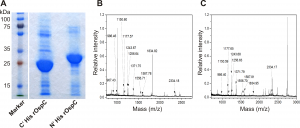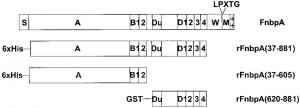Abstract
For years, the use of polyhistidine tags (His-tags) has been a staple in the isolation of recombinant proteins in immobilized metal affinity chromatography experiments. Its use has been highly beneficial in increasing the protein purity of crude cell lysates. For some recombinant proteins, one consequence of the addition of the His tag is that it can affect protein function and stability.
Functional proteins are essential in elucidating their biological, kinetic, structural, and thermodynamic properties. In this study, we determined the effect of N-terminal 6xHis-TF-tagged recombinant on the thermal stability of selected proteins by differential scanning fluorimetry and identified that His tag removal can have both beneficial and detrimental effects on their stability.

Introduction
The study of protein regulation, structure, and function relies heavily on the expression and purification of recombinant proteins. Many recombinant proteins are expressed as fusion proteins, meaning that they contain an affinity/epitope tag (eg, His or GST). A tag is a short DNA sequence encoding a specific amino acid, which is often inserted into a target gene at the coding point for N- or C-terminal expression of the required protein.
One of the most widely used tags is the polyhistidine tag, also known as His-Tag, which is a chain of between six and nine histidine residues. This labelling method is especially useful as it allows easy purification and detection of the recombinant protein.
His-Tag protein purification
Protein purification requires methods that are highly specific and robust, regardless of scale. Their tags allow researchers to selectively extract a protein of interest from the thousands of other proteins found in a cell or in a cell lysate. Purification of His-Tag proteins is performed by single-step immobilized metal affinity chromatography (IMAC); a specialized form of affinity chromatography in which proteins (or peptides) are separated according to their affinity for metal ions immobilized on a solid chelating resin.
Although many divalent metal ions (eg, Zn2+, Cu2+, Cd2+, Hg2+, Co2+, Ni2+, and Fe2+) can be used in IMAC, nickel (Ni2+) or cobalt (Co2+) are often used in chelating resins to coordinate and selectively join the His label. Nickel is generally used for higher protein yields, while cobalt is preferred for higher purity preparations.

His-Tag protein detection
Epitope tagging is a common method employed for protein identification and detection. Similarly, His-Tag also acts as a specific site for a binding partner, such as an antibody with high specificity, allowing easy detection of the recombinant protein of interest. Downstream applications such as SDS PAGE and Western blot can further detect and quantify His-Tag protein after purification to determine yield, especially when anti-His-Tag antibodies are available. Other uses include protein localization, protein-protein interaction, and immunoprecipitation studies.
Expedeon technologies for easy validation of His-Tag protein expression:
Traditional methods for evaluating the success of protein expression and purification can be tedious and time-consuming. Our His-Tag kit is a fast and easy competitive immunochromatography test developed to enable scientists to verify and monitor the successful expression of His-tagged recombinant proteins, prior to further downstream applications, in a single step.
Your Check&Go! is a simple qualitative immunochromatography test. The key component of the kit is a nitrocellulose membrane containing immobilized His-Tag protein on the “test line” (T line) and ULFA-tagged protein on the “control line” (Cline). An InnovaCoat®-GOLD anti-His-Tag 40nm antibody and an InnovaCoat®-GOLD 40nm anti-ULFA tag conjugate are used for detection.
Benefits of His-Tag include:
- Quick yes/no response during expression and purification processes
- Results in less than 15 minutes!
- Compatible with cell culture media and lysate
- Easy to use
- Cheaper than gel electrophoresis/Western blot
- Small sample volume required: 80 ul of diluted sample*/strip
- Stable C line signal intensity: independent of His-tagged protein levels

